|
Farming systems
There exist six different types of farming systems that are practiced for mussel
culture.
1. Bottom culture
This method is extensively followed in Netherlands. The mussel growing areas have
an average depth of 5 m. Seed measuring 10-15 mm in length are dredged from the
natural grounds and transplanted usually on muddy grounds. Before marketing the
mussels are again laid on firm sandy ground. The entire operations are mechanised
with machines for washing, separating clusters and removing the byssus. Bottom culture
has not been experimented in India.
2. Stake culture
This method is practiced in France and Philippines. It is suitable where the bottom
is muddy and the tidal amplitude is high. In France, poles (called bouchots) of
20 cm diameter and 3-4 m length are driven into the substratum to a depth of 1 m
in the intertidal area. The poles are spaced 1 m apart. Mussel seed collected on
horizontally placed ropes is removed and placed in plastic net tubing and wrapped
spirally around the bouchot. The mussels are harvested in 12-18 months when they
grow to 68 cm in length. This method is practised in northern France where the tidal
amplitude is about 15 m, exposing extensive areas of mud flats. It is desirable
to experiment this method along the Gujarat coast.
In the Philippines, bamboo poles are driven into the bottom where the water depth
is 2-5 m. They are spaced 1 m apart. The natural setting of spat on the poles is
allowed to grow for 6-8 months to reach the marketable size of about 5 cm. The production
is about 15 kg/4 m length of pole and about 50 t/ha. A variation of the single pole
method is to form a wigwam wherein about 10 poles are staked in 2 m circle and tied
together at the top. It is stated that this structure withstands the wave action
better than single poles.
|
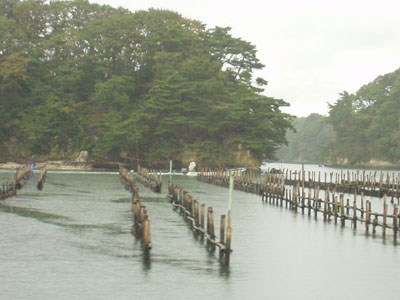
Stake culture
|
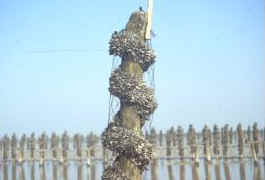
Bouchot culture
|
3. Rack and Bag culture
The strings used in oyster culture are replaced by flexible synthetic mesh tubing
of variable mesh size. Mussel seed of 10-15 mm in length are loaded in these tubes
and suspended from racks. This type of culture in shallower water, is gaining popularity,
and the problem of mussels slipping is overcome by this method.

Rack and Bag culture
4. Rope culture
Rope culture of mussel is widely adopted in Northern Kerala. Ropes are suspended
from rack made of casuarina and bamboo poles. The average area of rack is 400 m2
and length of the ropes used for seeding ranges from 1-1.25 m depending on the depth
of the water column. Polypropylene ropes wound with coir ropes are used for seeding.
These ropes are hung down from the racks at an interval of 1 feet and nearly 500
- 550 ropes could be suspended from one rack. The seeds collected from wild are
being sold in units of one bag and one bag of seed can be used to seed 8-10 ropes.
The normal size of the seed ranges from 35-65 mm. Seed collected has to be seeded
on the same day and it is estimated that one person can seed around 60-70 ropes
in a day. The culture period in Northern Kerala where the activity is taken up fairly
on a large scale starts from November and ends in the middle of May before the rains.
Once in a fortnight the ropes are lifted for monitoring the growth and removal of
fowling organisms. The mussel grows to 80-100 mm size within 6 months of culture
period and it is estimated that around 2 lakhs mussels can be harvested from 400
m2.
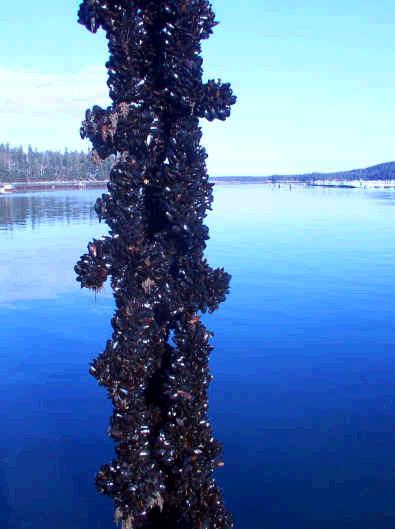
Rope culture
5. Raft culture
Spain is the leading producer of mussels in the world by the raft method. In the
Galician Bays on the northwest coast of Spain, 20 m x 20 m size rafts made from
eucalyptus wood are moored. Seed measuring 10 mm are collected either from the natural
grounds or on ropes hung from rafts. About 500 numbers of 10 m long seeded ropes
are suspended from a single raft. The ropes have 25 cm long plastic pegs at every
40 cm length to prevent the mussels from sliding down the rope. The mussels grow
to the market size of 8-9 cm in 16-18 months. A 10 m long rope yields 100 kg of
mussels and the production per raft is 50 t.
This method has been widely experimented at several locations in India and gave
highly gratifying results. Rafts are moored in sheltered bays and also in the open
sea under favourable conditions in depths of 5 m or more. Rafts made of teakwood
or bamboo poles, measuring from 5 m x 5 m to 8 m x 8 m sizes have been used in India.
P. viridis: The size
of the seed ranges from 20 mm to 30 mm in length. About 500 to 700 g of seed is
used in one metre length of rope. Coir ropes of 20-25 mm diameter and nylon rope
of 14 mm diameter are used for growing the mussels. The mussel seed are spread over
25 cm wide knitted cotton clothes and the rope is kept over the mussel seed on the
knitted cloth. To prevent the slipping of mussels in the initial stages of growth,
wooden pegs are inserted in the rope at fixed intervals. The knitted cloth is wrapped
over the rope, securing the mussel seed and both the ends of the knitted cloth are
stitched with cotton twine. The seeded part of the rope measures 5 m to 8 m and
the ropes are suspended from the raft, 0.5 to 1 m apart. Care is taken to ensure
that the end of the rope is about 2 m above sea bottom. The mussels attach to the
ropes in 2-3 days and the cloth cover disintegrates in about 10 days.
Farm management involves maintenance of the raft, thinning; the ropes if necessary
and removal of the fouling organisms etc. Accumulation of silt and growth of plants
over the mussels’ arc found to be negligible at Calicut. The common foulers
arc barnacles, tubiculous polychaetes, ascidians, coelenterates and bryozoans. Heavy
settlement of the barnacle, Ralanus amphitrite, is common, particularly
at the upper 2 m length of the suspended rope. Periodically the foulers are removed
manually. Also, exposure of the ropes for a couple of hours to atmosphere helps
to kill the larvae of fouling organisms. Crabs, lobsters and fishes are the predators
of mussels. The duration of culture is 5 months at Calicut and the ropes seeded
in November are harvested in April. The mussels attain 80-88 mm in length (wt 36-40
g) at harvest.
P. indica: Smaller
rafts of 6 x 6 m and 5 x 4 m size were used in the Vizhinjam Bay and open sea off
Vizhinjam. The average weight of mussel seed per metre length of rope ranged from
1.4 Kg to 2 kg and they have attained 10-15 kg in 7 months in the bay and 15 kg
in 5 months in the open sea. With the average production per metre length of rope
at 12.5 kg and the seeded portion of rope 5 m, a total of 50 ropes suspended from
a 6 x 6 m raft yield 3.1 t of mussels in 7-8 months in the Vizhinjam Bay. The production
in the open sea is still higher at 3.75 t/raft/5 months.
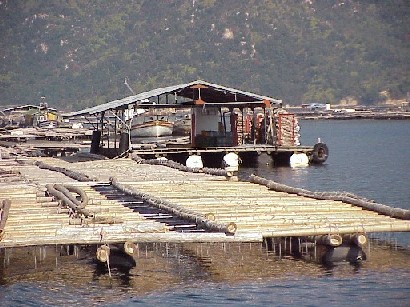
Raft culture
6. Longline culture
The longline system developed for mussel culture in the last 20 years is fast emerging
as the most important method throughout the world for mussel culture. It is derived
from the Japanese longlines used for culturing oysters, pearl oysters and scallops.
The longline method of culture is well developed in China, New Zealand, Korea, Italy
and Chile.
The longline system consits of a main line, floats, anchors, marking buoys and connecting
ropes. The longlines are made of 16 mm to 20 mm diameter synthetic rope. The main
rope (longline) is 150 m long and at every 5 m length, a 220 litre barrel is tied
to it and anchored with concrete blocks. Ropes with mussel seed are suspended from
the main rope. Spat collection ropes are also hung from the same longline, and often
these are directly used for growing the mussels. In the Netherlands the European
mussel Mytilus edulis grown on longlines reaches the marketable size of
40-45 mm in 12-14 months and the production is 10 kg/m ropes. Longline method of
mussel culture has not been attempted in India.
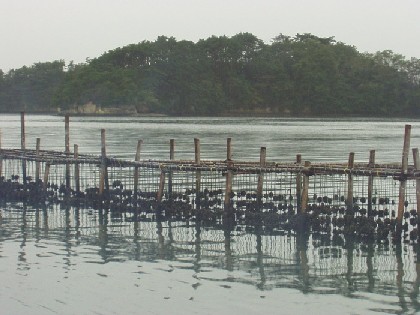
Longline culture
(Source: www.photolib.noaa.gov)
Top
|